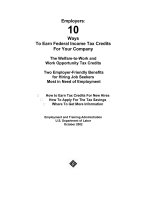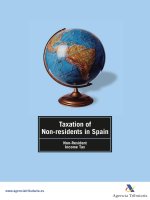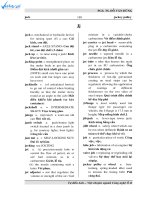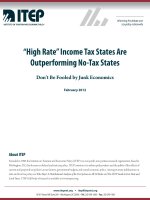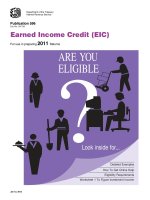J k lassers your income tax 2019 for preparing your 2018 tax return
Bạn đang xem bản rút gọn của tài liệu. Xem và tải ngay bản đầy đủ của tài liệu tại đây (26.79 MB, 1,633 trang )
Staff for This Book
J.K. Lasser Editorial
Elliott Eiss, Member of the New Y ork Bar, Contributing Editor
Barbara Weltman, Member of the New Y ork Bar, Contributing Editor
Angelo C. Jack, Production Manager
William Hamill, Copyediting and Proofreading
Index by WordCo Indexing Services
John Wiley & Sons, Inc.
John Wiley & Sons, Inc.
111 River Street
Hoboken, NJ 07030
Copyright © 2019 by John Wiley & Sons, Inc.
All rights reserved.
Published by John Wiley & Sons, Inc., Hoboken, New Jersey
Published simultaneously in Canada
No part of this publication may be reproduced, stored in a retrieval system, or transmitted in any form or by any means,
electronic, mechanical, photocopying, recording, scanning, or otherwise, except as permitted under Section 107 or 108 of
the 1976 United States Copyright Act, without either the prior written permission of the Publisher, or authorization
through payment of the appropriate per-copy fee to the Copyright Clearance Center, Inc., 222 Rosewood Drive, Danvers,
MA 01923, (978) 750-8400, fax (978) 646-8600, or on the web at www.copyright.com. Requests to the Publisher for
permission should be addressed to the Permissions Department, John Wiley & Sons, Inc., 111 River Street, Hoboken, NJ
07030, (201) 748-6011, fax (201) 748-6008, or online at www.wiley.com/go/permissions.
Limit of Liability/Disclaimer of Warranty: While the publisher and author have used their best efforts in preparing this
book, they make no representations or warranties with respect to the accuracy or completeness of the contents of this
book and specifically disclaim any implied warranties of merchantability or fitness for a particular purpose. No warranty
may be created or extended by sales representatives or written sales materials. The advice and strategies contained herein
may not be suitable for your situation. Y ou should consult with a professional where appropriate. Neither the publisher
nor author shall be liable for any loss of profit or any other commercial damages, including but not limited to special,
incidental, consequential, or other damages.
For general information on our other products and services or for technical support, please contact our Customer Care
Department within the United States at (800) 762-2974, outside the United States at (317) 572-3993, or fax (317) 5724002.
Wiley also publishes its books in a variety of electronic formats. Some content that appears in print may not be available
in electronic books. For more information about Wiley products, visit our web site at www.wiley.com.
ISBN 978-1-119-53271-2 (paper)
ISBN 978-1-119-53267-5 (ePDF)
ISBN 978-1-119-53270-5 (ePub)
Eighty-Second Edition
How To Use Your Income Tax 2019
Tax alert symbols. Throughout the text of Your Income Tax, these special symbols alert
you to advisory tips about filing your federal tax return and tax planning opportunities:
Filing tip or Filing Instruction
A Filing Tip or Filing Instruction helps you prepare your 2018 return.
Planning Reminder
A Planning Reminder highlights year-end tax strategies for 2018 or planning
opportunities for 2019 and later years.
Caution
A Caution points out potential pitfalls to avoid and areas where IRS opposition may be
expected.
Law Alert
A Law Alert indicates recent changes in the tax law and pending legislation before
Congress.
Court Decision
A Court Decision highlights key rulings from the Tax Court and other federal courts.
IRS Alert
An IRS Alert highlights key rulings and announcements from the IRS.
Visit jklasser.com
for FREE download
of e-Supplement
You can download a free e-Supplement to Your Income Tax 2019 at jklasser.com. The
e-Supplement will provide an update on tax developments from the IRS and Congress,
including a look ahead to 2019.
On the homepage at jklasser.com, you will find free tax news, tax tips and tax planning
articles.
The federal income tax law, despite efforts at simplification, remains a maze of statutes,
regulations, rulings, and court decisions written in technical language covering thousands
and thousands of pages. For 82 years, J.K. Lasser’s™ Your Income Tax has aided and
guided millions of taxpayers through this complex law. Every effort has been made to
provide a direct and easy-to-understand explanation that shows how to comply with the
law and at the same time take advantage of tax-saving options and plans.
The 2019 edition of Your Income Tax—our 82nd edition—continues this tradition. To
make maximum use of this tax guide, we suggest that you use these aids:
Contents Chapter by Chapter. The contents, on pages v–xxv, lists the chapters in
Your Income Tax. References direct you to sections within a particular chapter. Thus a
reference to 21.1 directs you to Chapter 21 and then to section 1 within that chapter.
Section and page references are provided in the index at the back of the book.
What’s New for 2018. Pages xxvii–xxx alert you to tax developments that may affect
your 2018 tax return.
Key Tax Numbers for 2018. Pages xxxi–xxxiii.
Tax-Saving Opportunities. Page xxxiv.
Filing tax basics. Pages 1–8 alert you to filing requirements, filing addresses for IRS
Service Centers, and a calendar with 2019 filing deadlines.
CONTENTS
Cover
What’s New for 2018
Tax News for 2018
Key Tax Numbers for 2018
Tax-Saving Opportunities for 2018
Part 1 Filing Basics
Do You Have to File a 2018 Tax Return?
Filing Tests for Dependents: 2018 Returns
Where to File Your 2018 Form 1040
Filing Deadlines (on or before)
The New Form 1040 and 1040 Schedules
Chapter 1 Filing Status
1.1 Which Filing Status Should You Use?
1.2 Tax Rates Based on Filing Status
1.3 Filing Separately Instead of Jointly
1.4 Filing a Joint Return
1.5 Nonresident Alien Spouse
1.6 Community Property Rules
1.7 Innocent Spouse Rules
1.8 Separate Liability Relief for Former Spouses
1.9 Equitable Relief
1.10 Death of Your Spouse in 2018
1.11 Qualifying Widow/Widower Status for 2018 If Your Spouse Died in
2017 or 2016
1.12 Qualifying as Head of Household
1.13 Filing for Your Child
1.14 Return for Deceased
1.15 Return for an Incompetent Person
1.16 How a Nonresident Alien Is Taxed
1.17 How a Resident Alien Is Taxed
1.18 Who Is a Resident Alien?
1.19 Certificate of Tax Compliance for Alien Leaving the United States
1.20 Expatriation Tax
Part 2 Reporting Your Income
Chapter 2 Wages, Salary, and Other Compensation
2.1 Salary and Wage Income
2.2 Constructive Receipt of Year-End Paychecks
2.3 Pay Received in Property Is Taxed
2.4 Commissions Taxable When Credited
2.5 Unemployment Benefits
2.6 Strike Pay Benefits and Penalties
2.7 Nonqualified Deferred Compensation
2.8 Did You Return Wages Received in a Prior Year?
2.9 Waiver of Executor’s and Trustee’s Commissions
2.10 Life Insurance Benefits
2.11 Educational Benefits for Employees’ Children
2.12 Sick Pay Is Taxable
2.13 Workers’ Compensation Is Tax Free
2.14 Disability Pay and Pensions
2.15 Stock Appreciation Rights (SARs)
2.16 Stock Options
2.17 Restricted Stock
Chapter 3 Fringe Benefits
3.1 Tax-Free Health and Accident Coverage Under Employer Plans
3.2 Health Savings Accounts (HSAs) and Archer MSAs
3.3 Reimbursements and Other Tax-Free Payments From Employer Health
and Accident Plans
3.4 Group-Term Life Insurance Premiums
3.5 Dependent Care Assistance
3.6 Adoption Benefits
3.7 Education Assistance Plans
3.8 Company Cars, Parking, and Transit Passes
3.9 Working Condition Fringe Benefits
3.10 De Minimis Fringe Benefits
3.11 Employer-Provided Retirement Advice
3.12 Employee Achievement Awards
3.13 Employer-Furnished Meals or Lodging
3.14 Minister’s Housing or Housing Allowance
3.15 Cafeteria Plans Provide Choice of Benefits
3.16 Flexible Spending Arrangements
3.17 Company Services Provided at No Additional Cost
3.18 Discounts on Company Products or Services
Chapter 4 Dividend and Interest Income
4.1 Reporting Dividends and Mutual Fund Distributions
4.2 Qualified Corporate Dividends Taxed at Favorable Capital Gain Rates
4.3 Dividends From a Partnership, S Corporation, Estate, or Trust
4.4 Real Estate Investment Trust (REIT) Dividends
4.5 Taxable Dividends of Earnings and Profits
4.6 Stock Dividends on Common Stock
4.7 Dividends Paid in Property
4.8 Taxable Stock Dividends
4.9 Who Reports the Dividends
4.10 Year Dividends Are Reported
4.11 Distribution Not Out of Earnings: Return of Capital
4.12 Reporting Interest on Your Tax Return
4.13 Interest on Frozen Accounts Not Taxed
4.14 Interest Income on Debts Owed to You
4.15 Reporting Interest on Bonds Bought or Sold
4.16 Forfeiture of Interest on Premature Withdrawals
4.17 Amortization of Bond Premium
4.18 Discount on Bonds
4.19 Reporting Original Issue Discount on Your Return
4.20 Reporting Income on Market Discount Bonds
4.21 Discount on Short-Term Obligations
4.22 Stripped Coupon Bonds and Stock
4.23 Sale or Retirement of Bonds and Notes
4.24 State and City Interest Generally Tax Exempt
4.25 Taxable State and City Interest
4.26 Tax-Exempt Bonds Bought at a Discount
4.27 Treasury Bills, Notes, and Bonds
4.28 Interest on United States Savings Bonds
4.29 Deferring United States Savings Bond Interest
4.30 Minimum Interest Rules
4.31 Interest-Free or Below-Market-Interest Loans
4.32 Minimum Interest on Seller-Financed Sales
Chapter 5 Reporting Property Sales
5.1 General Tax Rules for Property Sales
5.2 How Property Sales Are Classified and Taxed
5.3 Capital Gains Rates and Holding Periods
5.4 Capital Losses and Carryovers
5.5 Capital Losses of Married Couples
5.6 Losses May Be Disallowed on Sales to Related Persons
5.7 Special Treatment of Gain on Sale of Small Business Stock or Qualified
Opportunity Zone Investment
5.8 Reporting Capital Asset Sales on Form 8949 and on Schedule D
5.9 Counting the Months in Your Holding Period
5.10 Holding Period for Securities
5.11 Holding Period for Real Estate
5.12 Holding Period: Gifts, Inheritances, and Other Property
5.13 Calculating Gain or Loss
5.14 Amount Realized Is the Total Selling Price
5.15 Finding Your Cost
5.16 Unadjusted Basis of Your Property
5.17 Basis of Property You Inherited or Received as a Gift
5.18 Joint Tenancy Basis Rules for Surviving Tenants
5.19 Allocating Cost Among Several Assets
5.20 How To Find Adjusted Basis
5.21 Tax Advantage of Installment Sales
5.22 Figuring the Taxable Part of Installment Payments
5.23 Electing Not To Report on the Installment Method
5.24 Restriction on Installment Sales to Relatives
5.25 Contingent Payment Sales
5.26 Using Escrow and Other Security Arrangements
5.27 Minimum Interest on Deferred Payment Sales
5.28 Dispositions of Installment Notes
5.29 Repossession of Personal Property Sold on Installment
5.30 Boot in Like-Kind Exchange Payable in Installments
5.31 “Interest” Tax if Sales Price Exceeds $150,000 With Over $5 Million
Debt
5.32 Worthless Securities
5.33 Tax Consequences of Bad Debts
5.34 Four Rules To Prove a Bad Debt Deduction
5.35 Family Bad Debts
Chapter 6 Tax-Free Exchanges of Property
6.1 Like-Kind Exchanges of Real Property
6.2 Receipt of Cash and Other Property—“Boot”
6.3 Time Limits and Security Arrangements for Deferred Exchanges
6.4 Qualified Exchange Accommodation Arrangements (QEAAs) for Reverse
Exchanges
6.5 Exchanges Between Related Parties
6.6 Property Transfers Between Spouses and Ex-Spouses
6.7 Tax-Free Exchanges of Stock in Same Corporation
6.8 Joint Ownership Interests
6.9 Setting up Closely Held Corporations
6.10 Tax-Free Exchanges of Insurance Policies
Chapter 7 Retirement and Annuity Income
7.1 Retirement Distributions on Form 1099-R
7.2 Lump-Sum Distributions
7.3 Lump-Sum Options If You Were Born Before January 2, 1936
7.4 Lump-Sum Payments Received by Beneficiary
7.5 Tax-Free Rollovers From Qualified Plans
7.6 Direct Rollover or Personal Rollover
7.7 Rollover of Proceeds From Sale of Property
7.8 Distribution of Employer Stock or Other Securities
7.9 Survivor Annuity for Spouse
7.10 Court Distributions to Former Spouse Under a QDRO
7.11 When You Must Begin Receiving Required Minimum Distributions
(RMDs)
7.12 Payouts to Beneficiaries
7.13 Penalty for Distributions Before Age 59½
3.14 Restrictions on Loans From Company Plans
7.15 Tax Benefits of 401(k) Plans
7.16 Limit on Salary-Reduction Deferrals
7.17 Withdrawals From 401(k) Plans Restricted
7.18 Designated Roth Account Within 401(k), 403(b), or Governmental 457
Plans
7.19 Annuities for Employees of Tax-Exempts and Schools (403(b) Plans)
7.20 Government and Exempt Organization Deferred Pay Plans
7.21 Figuring the Taxable Part of Commercial Annuities
7.22 Life Expectancy Tables
7.23 When You Convert Your Endowment Policy
7.24 Reporting Employee Annuities
7.25 Simplified Method for Calculating Taxable Employee Annuity
7.26 Employee’s Cost in Annuity
7.27 Withdrawals From Employer’s Qualified Retirement Plan Before
Annuity Starting Date
7.28 Special Rules for Victims of Hurricanes Harvey, Irma, Maria, and
California Wildfires
Chapter 8 IRAs
8.1 Starting a Traditional IRA
8.2 Contribution Limit for Traditional IRAs
8.3 Contributions to a Traditional IRA If You Are Married
8.4 Restrictions on Traditional IRA Deduction for Active Participants in
Employer Plans
8.5 Active Participation in Employer Plan
8.6 Nondeductible Contributions to Traditional IRAs
8.7 Penalty for Excess Contributions to Traditional IRAs
8.8 Distributions From Traditional IRAs
8.9 Partially Tax-Free Traditional IRA Distributions Allocable to
Nondeductible Contributions
8.10 Tax-Free Direct Transfer or Rollover From One Traditional IRA to
Another
8.11 Transfer of Traditional IRA to Spouse at Divorce
8.12 Penalty for Traditional IRA Withdrawals Before Age 59½
8.13 Mandatory Distributions From a Traditional IRA After Age 70½
8.14 Inherited Traditional IRAs
8.15 SEP Basics
8.16 Salary-Reduction SEP Set Up Before 1997
8.17 Who Is Eligible for a SIMPLE IRA?
8.18 SIMPLE IRA Contributions and Distributions
8.19 Roth IRA Advantages
8.20 Annual Contributions to a Roth IRA
8.21 Recharacterizing a Traditional IRA Contribution to a Roth IRA and Vice
Versa
8.22 Converting a Traditional IRA to a Roth IRA
8.23 Conversions Made After 2017 to a Roth IRA Cannot Be Recharacterized
8.24 Distributions From a Roth IRA
8.25 Distributions to Roth IRA Beneficiaries
8.26 Special IRA Rules for Victims of Hurricanes Harvey, Irma, Maria, and
California Wildfires
Chapter 9 Income From Real Estate Rentals and Royalties
9.1 Reporting Rental Real Estate Income and Expenses
9.2 Checklist of Rental Deductions
9.3 Distinguishing Between a Repair and an Improvement
9.4 Reporting Rents From a Multi-Unit Residence
9.5 Depreciation on Converting a Home to Rental Property
9.6 Renting a Residence to a Relative
9.7 Personal Use and Rental of a Residence During the Year
9.8 Counting Personal-Use Days and Rental Days for a Residence
9.9 Allocating Expenses of a Residence to Rental Days
9.10 IRS May Challenge Loss Claimed on Temporary Rental of Residence
Before Sale
9.11 Reporting Royalty Income
9.12 Production Costs of Books and Creative Properties
9.13 Deducting the Cost of Patents or Copyrights
9.14 Intangible Drilling Costs
9.15 Depletion Deduction
9.16 Oil and Gas Percentage Depletion
9.17 Qualified Business Income Deduction for Real Estate Activities
Chapter 10 Loss Restrictions: Passive Activities and At-Risk Limits
10.1 Rental Activities Generally Treated as Passive
10.2 Rental Real Estate Loss Allowance of up to $25,000
10.3 Real Estate Professionals
10.4 Participation May Avoid Passive Loss Restrictions
10.5 Classifying Business Activities as One or Several
10.6 Material Participation Tests for Business
10.7 Tax Credits of Passive Activities Limited
10.8 Determining Passive or Nonpassive Income and Loss
10.9 Passive Income Recharacterized as Nonpassive Income
10.10 Working Interests in Oil and Gas Wells
10.11 Partners and Members of LLCs and LLPs
10.12 Form 8582 and Other Tax Forms
10.13 Suspended Losses Allowed on Disposition of Your Interest
10.14 Suspended Tax Credits
10.15 Personal Service and Closely Held Corporations
10.16 Sales of Property and of Passive Activity Interests
10.17 At-Risk Limits
10.18 What Is At Risk?
10.19 Amounts Not At Risk
10.20 At-Risk Investment in Several Activities
10.21 Carryover of Disallowed Losses
10.22 Recapture of Losses Where At Risk Is Less Than Zero
Chapter 11 Other Income
11.1 Prizes and Awards
11.2 Lottery and Sweepstake Winnings
11.3 Gambling Winnings and Losses
11.4 Gifts and Inheritances
11.5 Refunds of State and Local Income Tax Deductions
11.6 Other Recovered Deductions
11.7 How Legal Damages Are Taxed
11.8 Cancellation of Debts You Owe
11.9 Schedule K-1
11.10 How Partners Report Partnership Profit and Loss
11.11 When a Partner Reports Income or Loss
11.12 Partnership Loss Limitations
11.13 Tax Audits of Partnerships
11.14 Stockholder Reporting of S Corporation Income or Loss
11.15 How Beneficiaries Report Estate or Trust Income
11.16 Reporting Income in Respect of a Decedent (IRD)
11.17 Deduction for Estate Tax Attributable to IRD
11.18 How Life Insurance Proceeds Are Taxed to a Beneficiary
11.19 A Policy with a Family Income Rider
11.20 Selling or Surrendering Life Insurance Policy
11.21 Jury Duty Fees
11.22 Foster Care Payments
Part 3 Claiming Deductions
Chapter 12 Deductions Allowed in Figuring Adjusted Gross Income
12.1 Figuring Adjusted Gross Income (AGI)
12.2 Claiming Deductions from Gross Income
12.3 Moving Costs Are Deductible Only by Qualifying Members of the U.S.
Armed Forces
Chapter 13 Claiming the Standard Deduction or Itemized Deductions
13.1 New Law Increases the Standard Deduction for 2018 and Cuts Back
Itemized Deductions
13.2 Can You Itemize Your Deductions?
13.3 Spouses Filing Separate Returns
13.4 Standard Deduction If 65 or Older or Blind
13.5 Standard Deduction for Dependents
13.6 Prepaying or Postponing Itemized Expenses
13.7 Itemized Deductions No Longer Reduced for Higher-Income Taxpayers
Chapter 14 Charitable Contribution Deductions
14.1 Deductible Contributions
14.2 Nondeductible Contributions
14.3 Contributions That Provide You With Benefits
14.4 Unreimbursed Expenses of Volunteer Workers
14.5 Support of a Student in Your Home
14.6 What Kind of Property Are You Donating?
14.7 Cars, Clothing, and Other Property Valued Below Cost
14.8 Bargain Sales of Appreciated Property
14.9 Art Objects
14.10 Interests in Real Estate
14.11 Life Insurance
14.12 Business Inventory
14.13 Donations Through Trusts
14.14 Records Needed To Substantiate Your Contributions
14.15 Form 8283 and Written Appraisal Requirements for Property
Donations
14.16 Penalty for Substantial Overvaluation of Property
14.17 Ceiling on Charitable Contributions
14.18 Carryover for Excess Donations
14.19 Election To Reduce Fair Market Value by Appreciation
Chapter 15 Itemized Deduction for Interest Expenses
15.1 Deduction for Home Mortgage Interest
15.2 Home Acquisition Loans
15.3 Home Equity Loans
15.4 Home Construction Loans
15.5 Mortgage Insurance Premiums and Other Payment Rules
15.6 Interest on Refinanced Loans
15.7 “Points”
15.8 Cooperative and Condominium Apartments
15.9 Investment Interest Limitations
15.10 Debts To Carry Tax-Exempt Obligations
15.11 Earmarking Use of Loan Proceeds For Investment or Business
15.12 Year To Claim an Interest Deduction
15.13 Prepaid Interest
Chapter 16 Deductions for Taxes
16.1 Overall Limit on Deduction for State and Local Taxes
16.2 Nondeductible Taxes
16.3 State and Local Income Taxes or General Sales Taxes
16.4 Deducting Real Estate Taxes
16.5 Assessments
16.6 Tenants’ Payment of Taxes
16.7 Allocating Taxes When You Sell or Buy Realty
16.8 Automobile License Fees
16.9 Taxes Deductible as Business Expenses
16.10 Foreign Taxes
Chapter 17 Medical and Dental Expense Deductions
17.1 Medical and Dental Expenses Must Exceed AGI Threshold
17.2 Allowable Medical and Dental Care Costs
17.3 Nondeductible Medical Expenses
17.4 Reimbursements Reduce Deductible Expenses
17.5 Expenses of Your Spouse
17.6 Expenses of Your Dependents
17.7 Decedent’s Medical Expenses
17.8 Premiums for Health Insurance
17.9 Travel Costs May Be Medical Deductions
17.10 Schooling for the Mentally or Physically Disabled
17.11 Nursing Homes
17.12 Nurses’ Wages
17.13 Home Improvements as Medical Expenses
17.14 Costs Deductible as Business Expenses
17.15 Long-Term Care Premiums and Services
17.16 Life Insurance Used by Chronically ill or Terminally ill Person
Chapter 18 Casualty and Theft Losses and Involuntary Conversions
18.1 Casualty or Theft Losses for Personal-Use Property Must be Due to a
Federally Declared Disaster
18.2 When To Deduct a Disaster Loss
18.3 Prior-Year Election for Disaster Losses
18.4 Gain Realized From Insurance Proceeds for Damaged or Destroyed
Principal Residence
18.5 Who May Deduct a Disaster Loss
18.6 Proving a Casualty Loss
18.7 Theft Losses
18.8 Floors for Personal-Use Property Losses
18.9 Figuring Your Loss on Form 4684
18.10 Personal and Business Use of Property
18.11 Repairs May Be a “Measure of Loss”
18.12 Excess Living Costs Paid by Insurance Are Not Taxable
18.13 Do Your Casualty or Theft Losses Exceed Your Income?
18.14 Defer Gain from Involuntary Conversion by Replacing Property
18.15 Involuntary Conversions Qualifying for Tax Deferral
18.16 How to Elect to Defer Gain
18.17 Types of Qualifying Replacement Property
18.18 Time Period for Buying Replacement Property
18.19 Cost of Replacement Property Determines Postponed Gain
18.20 Special Assessments and Severance Damages from Condemnation
Chapter 19 Other Itemized Deductions
19.1 Only a Few Expenses Are Allowed as “Other” Itemized Deductions
19.2 Deductions for Job Costs and Other Miscellaneous Expenses No Longer
Allowed
Chapter 20 Travel and Meal Expense Deductions
20.1 Who May Deduct Travel and Transportation Expenses
20.2 Commuting Expenses
20.3 Overnight-Sleep Test Limits Deduction of Meal Costs
20.4 IRS Meal Allowance
20.5 Business Trip Deductions
20.6 When Are You Away From Home?
20.7 Tax Home of Married Couple Working in Different Cities
20.8 Deducting Living Costs on Temporary Assignment
20.9 Business-Vacation Trips Within the United States
20.10 Business-Vacation Trips Outside the United States
20.11 Deducting Expenses of Business Conventions
20.12 Restrictions on Foreign Conventions and Cruises
20.13 Entertainment Expenses No Longer Deductible
20.14 Client Business Meals Still Generally Deductible
20.15 50% Cost Limitation on Most Deductible Meals
20.16 Substantiating Travel Expenses
20.17 Employee Reporting of Unreimbursed Expenses
20.18 Are You Reimbursed Under an Accountable Plan?
20.19 Per Diem Travel Allowance Under Accountable Plans
20.20 Automobile Mileage Allowance
20.21 Reimbursements Under Non-Accountable Plans
Part 4 Personal Tax Computations
Chapter 21 Dependents
21.1 New Law Suspends Exemption Deductions for You, Your Spouse, and
Your Dependents
21.2 How Many Dependents Do You Have?
21.3 Qualifying Children
21.4 Qualifying Relatives
21.5 Meeting the Support Test for a Qualifying Relative
21.6 Multiple Support Agreements
21.7 Special Rule for Divorced or Separated Parents
21.8 Reporting Social Security Numbers of Dependents
Chapter 22 Figuring Your Regular Income Tax Liability
22.1 Taxable Income and Regular Income Tax Liability
22.2 Using the Tax Table
22.3 Tax Computation Worksheet
22.4 Tax Calculation If You Have Net Capital Gain or Qualified Dividends
22.5 Foreign Earned Income Tax Worksheet
22.6 Income Averaging for Farmers and Fishermen
22.7 Tax Credits
22.8 Additional Medicare Tax and Net Investment Income Tax
Chapter 23 Alternative Minimum Tax (AMT)
23.1 Computing Alternative Minimum Tax on Form 6251
23.2 Adjustments and Preferences for AMT
23.3 Tax Credits Allowed Against AMT
23.4 Regular Tax Credit for Prior-Year AMT
23.5 Avoiding AMT
Chapter 24 Computing the “Kiddie Tax” on Your Child’s Unearned Income
24.1 Filing Your Child’s Return
24.2 Children Subject to “Kiddie Tax” for 2018
24.3 Computing “Kiddie Tax” on Child’s Return
24.4 Parent’s Election To Report Child’s Dividends and Interest
Chapter 25 Personal Tax Credits Reduce Your Tax Liability
25.1 Overview of Personal Tax Credits
25.2 Child Tax Credit for Children Under Age 17
25.3 Figuring the Child Tax Credit and Additional Child Tax Credit
25.4 New Credit for Other Dependents
25.5 Qualifying for the Child and Dependent Care Credit
25.6 Figuring the Child and Dependent Care Credit
25.7 Qualifying Tests for EIC
25.8 Income Tests for Earned Income Credit (EIC)
25.9 Qualifying for the Adoption Credit
25.10 Claiming the Adoption Credit on Form 8839
25.11 Eligibility for the Saver’s Credit
25.12 Figuring the Saver’s Credit
25.13 Premium Tax Credit
25.14 Health Coverage Credit
25.15 Mortgage Interest Credit
25.16 Residential Energy Credits
25.17 Credit for Qualified Plug-in Electric and Fuel Cell Vehicles
25.18 Repayment of the First-Time Homebuyer Credit
Chapter 26 Tax Withholdings
26.1 Withholdings Should Cover Estimated Tax
26.2 Income Taxes Withheld on Wages
26.3 Low Earners May Be Exempt From Withholding
26.4 Are You Withholding the Right Amount?
26.5 Voluntary Withholding on Government Payments
26.6 When Tips Are Subject to Withholding
26.7 Withholding on Gambling Winnings
26.8 FICA Withholdings
26.9 Withholding on Distributions from Retirement Plans and Commercial
Annuities
26.10 Backup Withholding
Chapter 27 Estimated Tax Payments
27.1 Do You Owe an Estimated Tax Penalty for 2018?
27.2 Planning Estimated Tax Payments for 2019
27.3 Dates for Paying Estimated Tax Installments for 2019
27.4 Estimates by Married Taxpayers
27.5 Adjusting Your Payments During the Year
Chapter 28 Additional Medicare Tax and Net Investment Income Tax
28.1 Higher-Income Taxpayers May be Subject to Additional Taxes
28.2 Additional 0.9% Medicare Tax on Earnings
28.3 Additional 3.8% Tax on Net Investment Income
Part 5 Tax Planning
Chapter 29 Tax Savings for Residence Sales
29.1 Avoiding Tax on Sale of Principal Residence
29.2 Meeting the Ownership and Use Tests for Exclusion
29.3 Home Sales by Married Persons
29.4 Reduced Maximum Exclusion
29.5 Figuring Gain or Loss
29.6 Figuring Adjusted Basis
29.7 Personal and Business Use of a Home
29.8 No Loss Allowed on Personal Residence
29.9 Loss on Residence Converted to Rental Property
29.10 Loss on Residence Acquired by Gift or Inheritance
Chapter 30 Tax Rules for Investors in Securities
30.1 Planning Year-End Securities Transactions
30.2 Earmarking Stock Lots
30.3 Sale of Stock Dividends
30.4 Stock Rights
30.5 Short Sales of Stock
30.6 Wash Sales
30.7 Convertible Stocks and Bonds
30.8 Stock Options
30.9 Sophisticated Financial Transactions
30.10 Investing in Tax-Exempts
30.11 Ordinary Loss for Small Business Stock (Section 1244)
30.12 Series EE Bonds
30.13 I Bonds
30.14 Trader, Dealer, or Investor?
30.15 Mark-to-Market Election for Traders
Chapter 31 Tax Savings for Investors in Real Estate
31.1 Real Estate Ventures
31.2 Sales of Subdivided Land—Dealer or Investor?
31.3 Exchanging Real Estate Without Tax
31.4 Timing Your Real Property Sales
31.5 Cancellation of a Lease
31.6 Sale of an Option
31.7 Granting of an Easement
31.8 Special Tax Credits for Real Estate Investments
31.9 Foreclosures, Repossessions, Short Sales, and Voluntary Conveyances
to Creditors
31.10 Restructuring Mortgage Debt
31.11 Abandonments
31.12 Seller’s Repossession After Buyer’s Default on Mortgage
31.13 Foreclosure on Mortgages Other Than Purchase Money
31.14 Foreclosure Sale to Third Party
31.15 Transferring Mortgaged Realty
31.16 QBI Deduction for REIT Dividends
Chapter 32 Tax Rules for Investors in Mutual Funds
32.1 Timing of Your Investment Can Affect Your Taxes
32.2 Reinvestment Plans
32.3 Mutual Fund Distributions Reported on Form 1099-DIV
32.4 Tax-Exempt Bond Funds
32.5 Fund Expenses
32.6 Tax Credits From Mutual Funds
32.7 How to Report Mutual Fund Distributions
32.8 Redemptions and Exchanges of Fund Shares
32.9 Basis of Redeemed Shares
32.10 Comparison of Basis Methods
32.11 Mutual Funds Compared to Exchange-Traded Funds
Chapter 33 Educational Tax Benefits
33.1 Scholarships and Grants
33.2 Tuition Reductions for College Employees
33.3 How Fulbright Awards Are Taxed
33.4 United States Savings Bond Tuition Plans
33.5 Contributing to a Qualified Tuition Program (Section 529 Plan)
33.6 Distributions From Qualified Tuition Programs (Section 529 Plans)
33.7 Education Tax Credits
33.8 American Opportunity Credit
33.9 Lifetime Learning Credit
33.10 Contributing to a Coverdell Education Savings Account (ESA)
33.11 Distributions From Coverdell ESAs
33.12 Tuition and Fees Deduction
33.13 Student Loan Interest Deduction
33.14 Types of Deductible Work-Related Costs
33.15 Work-Related Tests for Education Costs
33.16 Local Transportation and Travel Away From Home To Take Courses
Chapter 34 Special Tax Rules for Senior Citizens and the Disabled
34.1 Senior Citizens Get Certain Filing Breaks
34.2 Social Security Benefits Subject to Tax
34.3 Computing Taxable Social Security Benefits
34.4 Election for Lump-Sum Social Security Benefit Payment
34.5 Retiring on Social Security Benefits
34.6 How Tax on Social Security Reduces Your Earnings
34.7 Eligibility for the Credit for the Elderly or the Disabled
34.8 Figuring the Credit for the Elderly or Disabled
34.9 Tax Effects of Moving to a Continuing Care Facility
34.10 Medicare Part B and Part D Premiums for 2019
34.11 Special Tax Rules for the Disabled
34.12 ABLE Accounts
Chapter 35 Members of the Armed Forces
35.1 Taxable Armed Forces Pay and Benefits
35.2 Tax Breaks for Armed Forces Members
35.3 Deductions for Armed Forces Personnel
35.4 Tax-Free Pay for Service in Combat Zone
35.5 Tax Deadlines Extended for Combat Zone or Contingency Operation
Service
35.6 Tax Forgiveness for Combat Zone or Terrorist or Military Action Deaths
35.7 Extension To Pay Your Tax When Entering the Service
35.8 Tax Information for Reservists
Chapter 36 How To Treat Foreign Earned Income
36.1 Claiming the Foreign Earned Income Exclusion
36.2 What Is Foreign Earned Income?
36.3 Qualifying for the Foreign Earned Income Exclusion
36.4 How To Treat Housing Costs
36.5 Meeting the Foreign Residence or Physical Presence Test
36.6 Claiming Deductions
36.7 Exclusion Not Established When Your Return Is Due
36.8 Tax-Free Meals and Lodging for Workers in Camps
36.9 U. S. Virgin Islands, Samoa, Guam, and Northern Marianas
36.10 Earnings in Puerto Rico
36.11 Tax Treaties With Foreign Countries
36.12 Exchange Rates and Blocked Currency
36.13 Foreign Tax Credit or Deduction for Foreign Taxes Paid
Chapter 37 Planning Alimony and Marital Settlements
37.1 Rules for Pre-2019 Alimony Agreements
37.2 Decree or Agreement Required
37.3 Cash Payments Required
37.4 Payments Must Stop at Death
37.5 Child Support Payments Are Not Alimony
37.6 No Minimum Payment Period for Alimony
37.7 3rd Year Recapture If Alimony Drops by More Than $15,000
37.8 Legal Fees of Marital Settlements
37.9 Alimony Rules for 2019
Chapter 38 Other Taxes
38.1 Overview of Household Employment Taxes
38.2 Social Security and Medicare (FICA) Taxes for Household Employees
38.3 Filing Schedule H To Report Household Employment Taxes
38.4 Federal Unemployment Taxes (FUTA) for Household Employees
38.5 Individual Responsibility Penalty
38.6 Exemption from Individual Responsibility Payment
Chapter 39 Gift and Estate Tax Planning Basics
39.1 Gifts of Appreciated Property
39.2 Gift Tax Basics
39.3 Filing a Gift Tax Return
39.4 Gift Tax Credit
39.5 Custodial Accounts for Minors
39.6 Trusts in Family Planning
39.7 What is the Estate Tax?
39.8 Take Inventory and Estimate the Value of Your Potential Estate
39.9 Estate Tax for 2018
39.10 Planning for a Potential Estate Tax
Part 6 Business Tax Planning
Chapter 40 Income or Loss From Your Business or Profession
40.1 Forms of Doing Business
40.2 Reporting Self-Employed Income
40.3 Accounting Methods for Reporting Business Income


